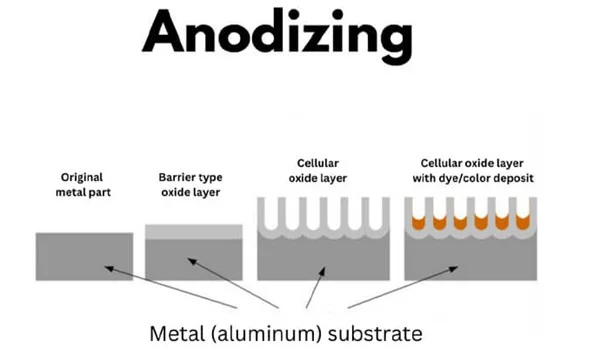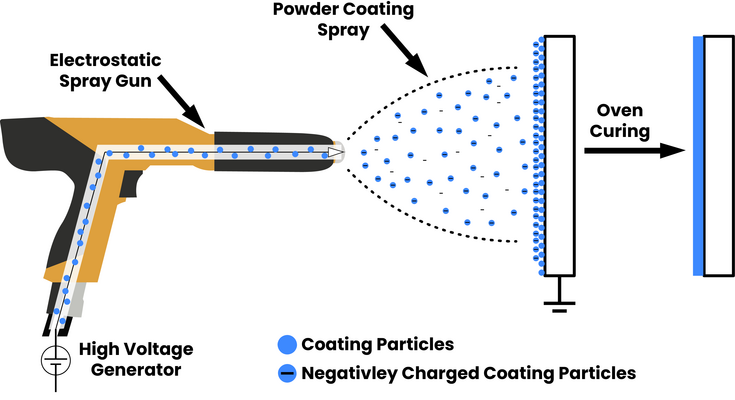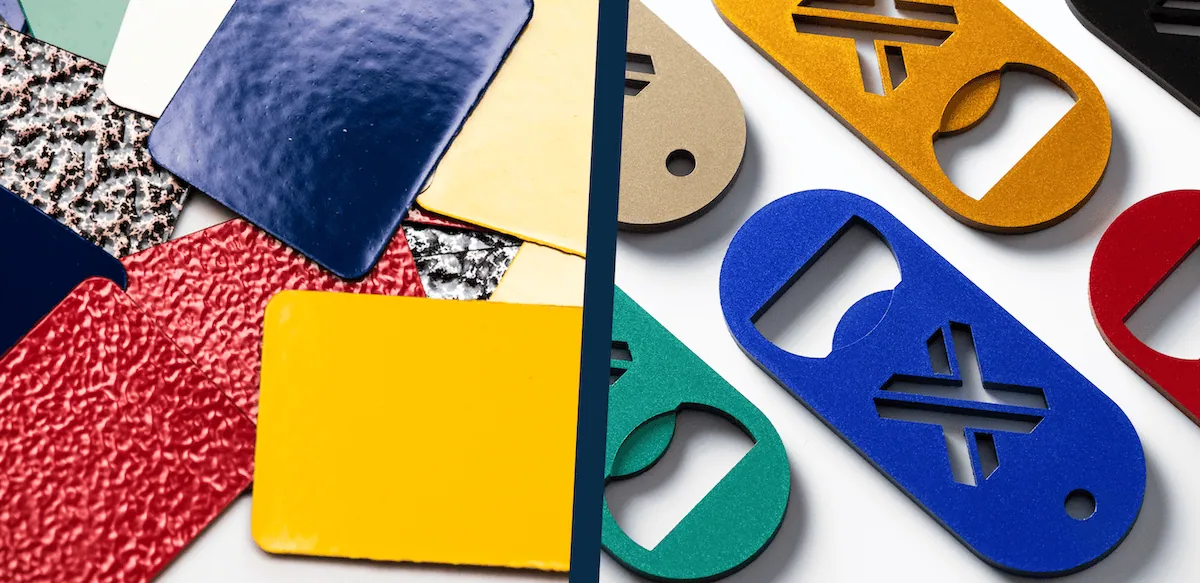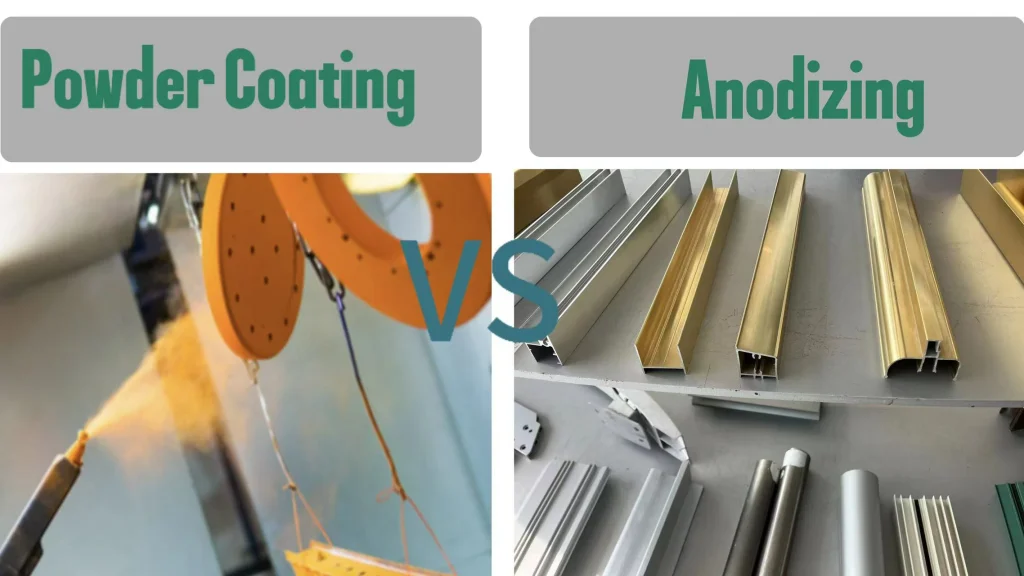When it comes to metal finishes, two options often rise to the top: Eloxieren Und Pulverbeschichtung. Both methods improve the Haltbarkeit, Aussehen, Und Korrosionsbeständigkeit of metal surfaces—especially aluminum. But while they may seem similar at first glance, they serve very different purposes depending on what your project requires.

In this guide, we’ll walk you through everything you need to know. From the core processes Und visual differences to the cost, applications, Und how to choose the right finish, you’ll get a clear picture of which option is the best fit for your needs. Let’s dive in!
What Is Anodizing?

Eloxieren is an electrochemical process that enhances the natural oxide layer on metals—most commonly Aluminium. This layer becomes thicker, harder, and more protective, giving the surface excellent corrosion resistance, improved scratch resistance, and a clean, metallic finish. Unlike paint or powder, anodizing becomes part of the metal, so it won’t chip, peel, or flake over time.
It also offers the flexibility to add Farbe through dyeing, without building up layers on the surface—perfect for projects that need a sleek, metallic look with added protection.
Key Benefits of Anodizing:
Creates a harder surface than powder coating
Excellent UV and weather resistance
Produces a natural metallic appearance
Supports color tinting without buildup or flaking
Anodizing is ideal for outdoor projects, architectural elements, and any application where durability and a refined aesthetic matter.
What Is Powder Coating?

Pulverbeschichtung is a popular dry finishing process that uses electrostatically charged powder, applied to a surface and then cured with heat. The result? A smooth, durable, and colorful layer that bonds tightly to the material. Unlike liquid paint, it doesn’t drip or run—and it covers surfaces evenly, even on complex shapes.
It works on metals like Aluminium and steel, and even some non-metal surfaces like MDF, making it a versatile option for both industrial and decorative use.
Key Benefits of Powder Coating:
Offers smooth decorative finishes in matte, gloss, or textured styles
Creates a thicker coating that resists impact, chemicals, and wear
Cost-effective for high-volume projects
Contains low VOCs, making it a grüner finishing method
If you want a vibrant, uniform look with great durability and lower costs, powder coating is a go-to choice—especially for items that don’t need extreme environmental resistance.
Key Differences Between Anodizing and Powder Coating
| Besonderheit | Eloxieren | Pulverbeschichtung |
| Process | Electrochemical oxidation | Electrostatic spray and heat cure |
| Haltbarkeit | Hard, integrated surface | Thick, protective surface layer |
| Color Range | Limited, natural metallic hues | Wide range of bright colors |
| UV Resistance | Excellent | Very good, but may fade over time |
| Korrosionsbeständigkeit | High (esp. with sealing) | High (with proper prep) |
| Kosten | Generally higher | More cost-effective |
| Surface Appearance | Metallic, shows material flaws | Smooth, hides imperfections |
| Umweltfreundlichkeit | Moderate (may produce byproducts) | High (no VOCs or solvents) |
1. Applications and Ideal Use Cases

Knowing when to choose anodizing vs. powder coat can save time, money, and headaches. Each finish shines in specific scenarios—so let’s break it down.
When to Use Anodizing
Anodizing is ideal for aerospace parts, marine components, architecture, and any application requiring a permanent, durable, and UV-stable finish. It’s also perfect for projects where scratch resistance Und metallic aesthetics are critical.
When to Use Powder Coating
Powder coating suits automotive parts, appliances, furniture, Und signage where bright colors, thicker coverage, or custom finishes are preferred. It’s best for indoor/outdoor items where minor surface flaws should be hidden.
2. Cost Comparison
Powder coating is typically more affordable due to simpler setup and materials. Anodizing costs more due to specialized equipment, longer processing time, and stricter chemical handling. However, anodizing’s Langlebigkeit can offset the higher initial expense in high-performance applications.
3. Aesthetic and Color Differences

Anodizing gives a metallic look that blends into the substrate, resulting in a sleek, natural feel. Its colors are often less vibrant, but won’t peel. Powder coating offers bold, consistent hues and can match brand colors easily. It’s also better at hiding defects.
4. Environmental Impact

Powder coating is generally more eco-friendly, emitting no VOCs and generating minimal waste. Anodizing can produce hazardous waste depending on the chemicals used, but modern methods use recyclable electrolytes and limit emissions. Proper waste management is key in both.
5. Maintenance Requirements

Both finishes are easy to maintain. Just clean regularly with mild soap and water—no harsh chemicals or abrasives. Powder coating can scratch if impacted, while anodized surfaces may dull in high-contact zones. Gentle upkeep keeps either finish looking fresh and lasting longer.
Can You Combine Both?

Technically, yes—but it’s not ideal. Applying powder coating over anodized aluminum demands special surface prep and can cancel out the benefits of both finishes. Unless you have a highly specific requirement, it’s smarter to choose one finish based on your project’s durability and appearance needs.
How to Choose the Right Finish

Not sure which finish fits best? Let’s break it down simply. Ask yourself what matters most—Haltbarkeit, Farbe, cost, oder look—and match it to your needs:
Environment: If your product faces harsh weather or direct UV exposure, anodizing offers better long-term protection.
Color Needs: Want bold shades or branded colors? Pulverbeschichtung gives you more vibrant and varied options.
Haltbarkeit: If the surface sees friction or repeated wear, anodizing’s hard oxide layer holds up longer.
Budget: Working with limited funds? Powder coating usually costs less upfront.
Ästhetik: Love that raw metallic sheen? Anodizing wins. Prefer a smooth, flawless finish? Powder coating’s your go-to.
FAQs
1. Which finish lasts longer—anodizing or powder coating?
Anodizing typically lasts longer since it becomes part of the metal surface. It performs especially well in harsh outdoor environments or high-wear areas.
2. Can you powder coat anodized aluminum?
Yes, but it’s not ideal. The anodized surface needs to be sanded or etched for the powder to stick. You’ll usually get better results by choosing one method from the start.
3. Is powder coating waterproof?
Powder coating is water-resistant. But if it chips or cracks, water can reach the metal underneath and cause corrosion.
Abschluss

Both anodizing and powder coating offer durable, attractive finishes for metal surfaces. Choosing the right one depends on your project’s needs—anodizing for UV stability and scratch resistance, oder powder coating for color variety and cost-efficiency. Consider application, budget, and environment before making your decision.
Still unsure which finish is right for your product? Kontaktieren Sie uns noch heute for expert advice tailored to your project. We’ll help you select the most reliable, cost-effective solution to ensure long-lasting performance and great aesthetics.
![Apro-Logo – 7 Vorteile von Aluminiumtüren: Haltbarkeit und Effizienz [2025] – APRO Apro-Logo](https://aprowin.com/wp-content/uploads/2024/08/Apro-logo.webp)
![A bifold glass door opens to a serene courtyard featuring a beautiful fountain at its center - 7 Benefits of Aluminum Doors: Durability and Efficiency [2025] - APRO Eine Faltglastür öffnet sich zu einem ruhigen Innenhof mit einem wunderschönen Brunnen in der Mitte](https://aprowin.com/wp-content/uploads/2024/10/A-bifold-glass-door-opens-to-a-serene-courtyard-featuring-a-beautiful-fountain-at-its-center.webp)
![Sunflower view through modern black aluminum window frame - 7 Benefits of Aluminum Doors: Durability and Efficiency [2025] - APRO Blick auf Sonnenblumen durch einen modernen schwarzen Aluminiumfensterrahmen](https://aprowin.com/wp-content/uploads/2024/10/Sunflower-view-through-modern-black-aluminum-window-frame.webp)
![Modern entrance featuring glass doors and awning for commercial projects - 7 Benefits of Aluminum Doors: Durability and Efficiency [2025] - APRO Moderner Eingang mit Glastüren und Markise für gewerbliche Projekte](https://aprowin.com/wp-content/uploads/2024/10/Modern-entrance-featuring-glass-doors-and-awning-for-commercial-projects.webp)
![Stylish residential project showcasing modern architecture and a beautiful pool area - 7 Benefits of Aluminum Doors: Durability and Efficiency [2025] - APRO Stilvolles Wohnprojekt mit moderner Architektur und wunderschönem Poolbereich](https://aprowin.com/wp-content/uploads/2024/10/Stylish-residential-project-showcasing-modern-architecture-and-a-beautiful-pool-area.webp)

![Sliding doors with black frames showcasing outdoor scenery - 16 Aluminum Doors and Windows Suppliers in Philippines [2025] - APRO Schiebetüren mit schwarzen Rahmen präsentieren die Außenlandschaft](https://aprowin.com/wp-content/uploads/2024/12/Sliding-doors-with-black-frames-showcasing-outdoor-scenery-500x368.webp)

![Remove the Frame and Track Remove A Sliding Glass Door - How to Remove Sliding Glass Doors Safely [September 2025] - APRO Entfernen Sie den Rahmen und die Schiene Entfernen Sie eine Glasschiebetür](https://aprowin.com/wp-content/uploads/2024/12/Remove-the-Frame-and-Track_-Remove-A-Sliding-Glass-Door-500x320.webp)
![A partially painted front door with taped glass panes - How to Paint an Aluminum Door Easily [September 2025] - APRO Eine teilweise bemalte Haustür mit verklebten Glasscheiben](https://aprowin.com/wp-content/uploads/2024/12/A-partially-painted-front-door-with-taped-glass-panes-357x500.webp)
![Diagram showcasing different types of weatherstripping including door sweeps spring vinyl and magnetic strips - Types of Weatherstripping for Doors [2025] - APRO Diagramm mit verschiedenen Arten von Dichtungsstreifen, einschließlich Türdichtungen, Federvinyl und Magnetstreifen](https://aprowin.com/wp-content/uploads/2024/12/Diagram-showcasing-different-types-of-weatherstripping-including-door-sweeps-spring-vinyl-and-magnetic-strips-500x465.webp)
![Worn hinge on an aluminum door showing signs of aging - 25 Types of Door Hinges and Their Best Uses [September 2025] - APRO Abgenutztes Scharnier an einer Aluminiumtür mit Alterserscheinungen](https://aprowin.com/wp-content/uploads/2024/12/Worn-hinge-on-an-aluminum-door-showing-signs-of-aging-500x341.webp)
![APRO logo white - 7 Benefits of Aluminum Doors: Durability and Efficiency [2025] - APRO APRO Logo weiß](https://aprowin.com/wp-content/uploads/2024/07/APRO-logo-white.webp)